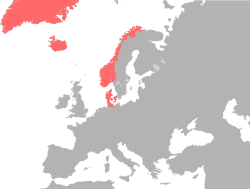Danish–Norwegian union
| Denmark–Norway | ||||||||||||
| Danmark–Norge | ||||||||||||
|
Personal union (1523–1533) Dualistic unitary state (Real union) (1537–1814) |
||||||||||||
|
||||||||||||
|
Map of Denmark–Norway, c. 1780
|
||||||||||||
| Capital |
Copenhagen and Oslo (Only in Norway 1523–1537) |
|||||||||||
| Languages |
Official: Danish, German, Renaissance Latin Also spoken: Norwegian, Icelandic, Faroese, Sami, Greenlandic |
|||||||||||
| Religion | Lutheran | |||||||||||
| Government |
Monarchy Denmark Elective monarchy 1523–1660 Hereditary absolute monarchy 1660–1814 Norway Elective monarchy 1523–1537 (de facto) Hereditary monarchy 1537–1814 (Absolute from 1661) |
|||||||||||
| King | ||||||||||||
| • | 1524–1533 | Frederick I | ||||||||||
| • | 1588–1648 | Christian IV | ||||||||||
| • | 1648–1670 | Frederick III | ||||||||||
| • | 1808–1814a | Frederick VI | ||||||||||
| Legislature |
|
|||||||||||
| Historical era | Early modern Europe | |||||||||||
| • |
Gustav Vasa elected King of Sweden |
June 6, 1523 |
||||||||||
| • | Kalmar Union collapsed | 1523 | ||||||||||
| • | Norwegian riksråd abolished |
1537 |
||||||||||
| • | Danish rigsråd abolished |
October 14, 1660 |
||||||||||
| • |
Lex Regia confirms absolutism |
November 14, 1665 |
||||||||||
| • | Treaty of Brömsebro | August 13, 1645 | ||||||||||
| • | Treaty of Roskilde | February 26, 1658 | ||||||||||
| • | Treaty of Kiel | January 14, 1814 | ||||||||||
| • | Congress of Vienna | September 1814 – June 1815 | ||||||||||
| Area | ||||||||||||
| • | 1780b | 487,476 km2 (188,216 sq mi) | ||||||||||
| Population | ||||||||||||
| • | 1645c est. | 1,315,000 | ||||||||||
| • | 1801d est. | 1,859,000 | ||||||||||
| Currency | ||||||||||||
|
||||||||||||
| Today part of | ||||||||||||
|
||||||||||||
As territory
As colonies
Denmark–Norway (Danish and Norwegian: Danmark–Norge; also known as the Oldenburg Monarchy or the Oldenburg realms) was an early modern multi-national and multi-lingual real union consisting of the Kingdom of Denmark, the Kingdom of Norway (including Norwegian overseas possessions the Faroe Islands, Iceland, Greenland, et cetera), the Duchy of Schleswig, and the Duchy of Holstein. The state also claimed sovereignty over two historical peoples: Wends and Goths. In addition, the state included the colonies of St. Thomas, St. John, St. Croix, Ghana, Tharangambadi, Serampore, and the Nicobar Islands. The state's inhabitants were mainly Danes, Norwegians, and Germans, and also included Faroese, Icelanders and Inuit in the Norwegian overseas possessions, a Sami minority in northern Norway, as well as indigenous peoples and enslaved Africans in the colonies. The state's main cities were Copenhagen, Christiania (Oslo), Altona, Bergen and Trondheim; its primary official languages were Danish and German. Norwegian, Icelandic, Faroese, Sami and Greenlandic were also spoken.
...
Wikipedia



